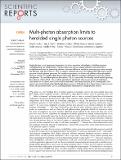Files in this item
Multi-photon absorption limits to heralded single photon sources
Item metadata
| dc.contributor.author | Husko, Chad A. | |
| dc.contributor.author | Clark, Alex S. | |
| dc.contributor.author | Collins, Matthew J. | |
| dc.contributor.author | De Rossi, Alfredo | |
| dc.contributor.author | Combrie, Sylvain | |
| dc.contributor.author | Lehoucq, Gaelle | |
| dc.contributor.author | Rey, Isabella H. | |
| dc.contributor.author | Krauss, Thomas F. | |
| dc.contributor.author | Xiong, Chunle | |
| dc.contributor.author | Eggleton, Benjamin J. | |
| dc.date.accessioned | 2014-05-02T12:01:02Z | |
| dc.date.available | 2014-05-02T12:01:02Z | |
| dc.date.issued | 2013-11-04 | |
| dc.identifier | 115276782 | |
| dc.identifier | 8db98ac7-a011-46f2-a9b3-3010343fe8f4 | |
| dc.identifier | 000326495500001 | |
| dc.identifier | 84889264138 | |
| dc.identifier.citation | Husko , C A , Clark , A S , Collins , M J , De Rossi , A , Combrie , S , Lehoucq , G , Rey , I H , Krauss , T F , Xiong , C & Eggleton , B J 2013 , ' Multi-photon absorption limits to heralded single photon sources ' , Scientific Reports , vol. 3 , 3087 . https://doi.org/10.1038/srep03087 | en |
| dc.identifier.issn | 2045-2322 | |
| dc.identifier.uri | https://hdl.handle.net/10023/4700 | |
| dc.description | This work was supported in part by the Centre of Excellence (CUDOS, project number CE110001018), Laureate Fellowship (FL120100029) and Discovery Early Career Researcher Award (DE120102069, DE130101148, and DE120100226) programs of the Australian Research Council (ARC), EPSRC UK Silicon Photonics (Grant reference EP/F001428/1), EU FP7 GOSPEL project (grant no. 219299), and EU FP7 COPERNICUS (grant no. 249012). | en |
| dc.description.abstract | Single photons are of paramount importance to future quantum technologies, including quantum communication and computation. Nonlinear photonic devices using parametric processes offer a straightforward route to generating photons, however additional nonlinear processes may come into play and interfere with these sources. Here we analyse spontaneous four-wave mixing (SFWM) sources in the presence of multi-photon processes. We conduct experiments in silicon and gallium indium phosphide photonic crystal waveguides which display inherently different nonlinear absorption processes, namely two-photon (TPA) and three-photon absorption (ThPA), respectively. We develop a novel model capturing these diverse effects which is in excellent quantitative agreement with measurements of brightness, coincidence-to-accidental ratio (CAR) and second-order correlation function g((2))(0), showing that TPA imposes an intrinsic limit on heralded single photon sources. We build on these observations to devise a new metric, the quantum utility (QMU), enabling further optimisation of single photon sources. | |
| dc.format.extent | 8 | |
| dc.format.extent | 992536 | |
| dc.language.iso | eng | |
| dc.relation.ispartof | Scientific Reports | en |
| dc.subject | Crystal wave-guides | en |
| dc.subject | Self-phase modulation | en |
| dc.subject | Slow-light | en |
| dc.subject | Pair generation | en |
| dc.subject | Correlated photons | en |
| dc.subject | 2-photon absorption | en |
| dc.subject | Wavelength conversion | en |
| dc.subject | Resonator | en |
| dc.subject | Dispersion | en |
| dc.subject | Fiber | en |
| dc.subject | QC Physics | en |
| dc.subject.lcc | QC | en |
| dc.title | Multi-photon absorption limits to heralded single photon sources | en |
| dc.type | Journal article | en |
| dc.contributor.institution | University of St Andrews. School of Physics and Astronomy | en |
| dc.identifier.doi | https://doi.org/10.1038/srep03087 | |
| dc.description.status | Peer reviewed | en |
| dc.identifier.url | http://www.nature.com/srep/2013/131030/srep03087/full/srep03087.html | en |
This item appears in the following Collection(s)
Items in the St Andrews Research Repository are protected by copyright, with all rights reserved, unless otherwise indicated.

